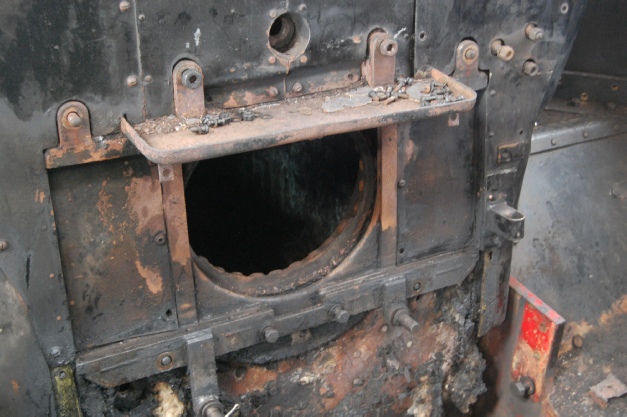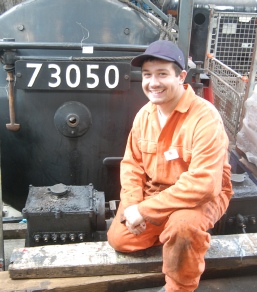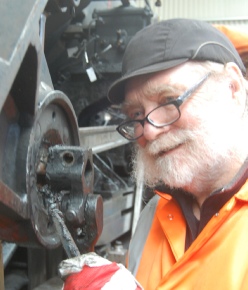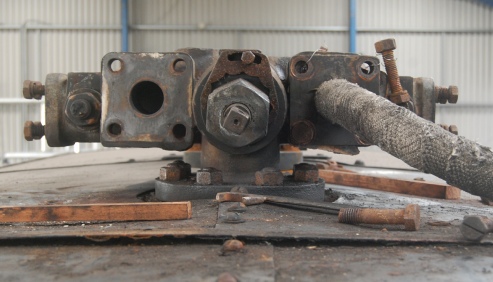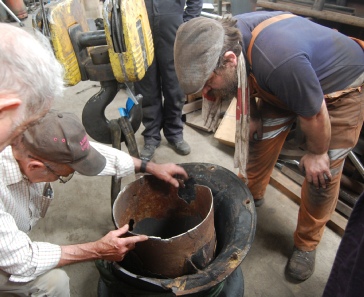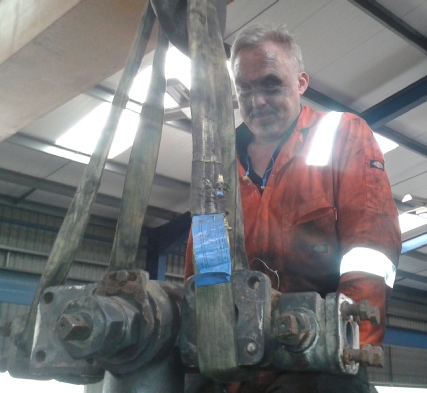8th June 2017.
With most of 92 Sq personnel on cleaning duties, it was a somewhat depleted workforce this week but some significant bits came off and the container is now even fuller of dirty components.
In the tender, Roland made up some modifications to the tender repair plates to avoid a ‘step’ where the firemans shovel would jar. These are now loaded into the tender and previously-painted areas marked for needle-gunning before welding next week. Geoff and Alastair got the cab front (AKA Spectacle Plate) completely detached. Using the crane the spectacle plate was carefully lowered to the workshop floor.
Paul Reeson detached the obstinate LHS clack and triumphantly craned it down to floor level. He also removed 9 saddle bolt heads from the area where the smokebox and tubeplate meet the saddle.
Graham and Alan brought down two running board brackets (L1 & L2) that Clifford had loosened on Monday and then hit a difficult one, which consumed the rest of the day.
Stan (D) and Ken worked on the RHS lubricator and, having disconnected the operating linkage, freed the oil pipes and the fixing bolts so that the lubricator could be lowered for tagging and photography. On Thursday, Victor (a visiting student from France) repeated the trick with the LHS lubricator.
Staff members Vince and Pete built a 'hanging plate' that can be used to hold up the ejector 'snail' under the chimney while the chimney tail is sliced off to release the hopelessly corroded-on snail. Unfortunately, electrical work rendered the crane (and lighting and grinders) inoperative for most of the day meant the we couldn't use it yet. V&P also burned off an 'immovable' bolt holding the RHS injector steam pipe at the top-of-firebox 'turret. Access the turret fixing bolts is now possible, so it should be down soon. Pete also removed the dome cover bolts, so it too can come down when someone has the crane for 5 minutes.
Off the loco, Consultation with Dave Head has helped decide that the 'snail' is beyond repair (internal holes are corroded, side has worn through) and will need replacement. Dave thinks he knows where a pattern for the casting is. The chimney also looks in very poor condition (LHS front shows several cracks) and further inspection once down will decide whether to seek a new one.
DOC advised us of the possibility that Tornado could be offered use of the workshop between December and March. This would mean moving 73050's chassis out of the shed and, in all probability, ceasing work on it for 4 months. By then we'll have enough components to clean and overhaul to keep us busy for more than 4 months so it should work out without any harm to the overall project timeline. We may need additional storage to make that mode of working possible.
It's been decided that Williamsons paint will be used for the loco. Although there are some attractions in the local supply and close support that Craftmaster can offer, this loco is too high profile to be the one on which we climb the inevitable learning curve that a different brand of paint is will bring. A volunteer-newsletter poll is ongoing to sound out the memberships view on livery for the loco on return to service.
Looking forward tactically on the loco, there are two areas of difficulty. Firstly under the cab, the final 2 tie bars need removal. Of the 4 bolts involved, 3 are badly corroded and the 4th is simply spinning when turned. Access under the loco is disgusting - oil, rust, ash, metal flakes. Secondly, in the smokebox, although Paul has ground off all-bar 3 of the bolt heads, there is no clearance to hit the exposed ends with a heavy hammer, we might need to get the superheater out to allow that access. Again very poor working conditions. Easier stuff - once the chimney and dome are down, we can remove the handrails and then the cladding/lagging. And once we've cleared the backhead, we can start taking off the cab sides.
Some publicity shots attached.
S.

